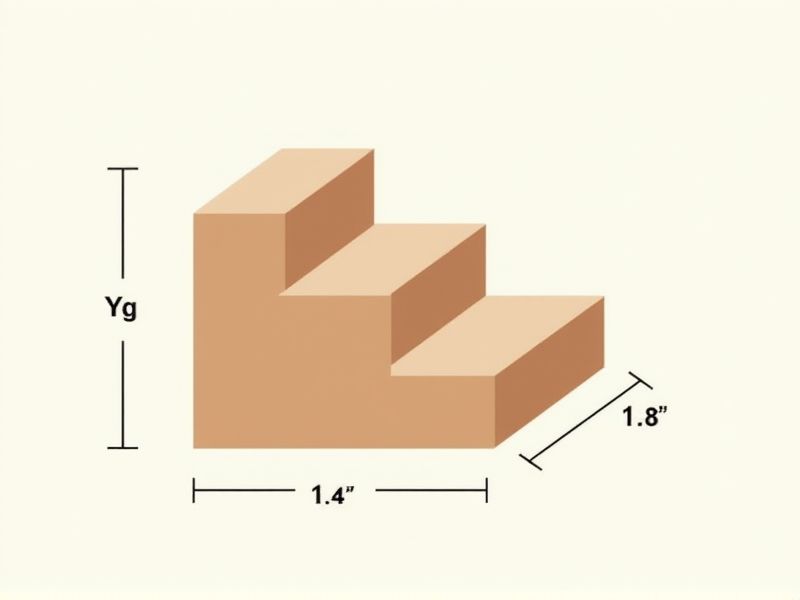
When designing safe and comfortable stairs, it's important to follow standard dimensions for the stair tread. Typically, a stair tread--the horizontal part where you place your foot--should be at least 10 inches (25.4 cm) deep from front to back. This provides enough space for most people to securely step as they ascend or descend the stairs. Always check your local building codes, as requirements can vary, but adhering to these standards helps ensure your stairs are both functional and safe for everyday use.
Code Compliance
Stair treads must adhere to specific code compliance standards to ensure safety and accessibility. The International Building Code (IBC) specifies that the minimum tread depth should be 11 inches, while the maximum riser height is limited to 7 inches. For residential settings, the National Fire Protection Association (NFPA) recommends maintaining uniformity in tread dimensions to prevent tripping hazards. Your project should also consider slip-resistant surfaces, as the Americans with Disabilities Act (ADA) mandates that treads provide adequate traction for users of all abilities.
Safety Regulations
Stair tread standards typically emphasize a minimum depth of 11 inches and a maximum riser height of 7 inches to ensure safety. The Americans with Disabilities Act (ADA) mandates that the edge of each stair tread must be visible, often requiring a contrasting color or a nosing of at least 1 inch. According to the Occupational Safety and Health Administration (OSHA), a secure grip is essential, which can be achieved by using materials with high slip resistance or incorporating textured surfaces. By adhering to these regulations, you can significantly reduce the risk of slips and falls in both residential and commercial settings.
Tread Depth
Stair tread depth is a critical factor in design, typically ranging from 11 to 14 inches for effective safety and comfort. The Americans with Disabilities Act (ADA) recommends a minimum tread depth of 11 inches to accommodate all users, ensuring a stable footing. Proper tread depth reduces the risk of slipping and increases accessibility, crucial for public buildings and residential spaces. For optimal usability, maintaining uniformity in tread depth across all stairs is essential, promoting a safer environment for you and your guests.
Tread Thickness
Tread thickness directly influences the safety and durability of stairs, with industry standards often recommending a minimum thickness of 1 inch for wood and 0.75 inches for other materials like metal and composite. A thicker tread provides better resistance to wear and reduces the risk of cracking, especially in high-traffic areas. For optimal safety, the National Safety Council suggests that treads should not be less than 11 inches in depth, ensuring ample surface area for foot placement. In your design, consider the balance between aesthetics and functionality by selecting appropriate tread thickness that meets both code requirements and personal preferences.
Nosing Requirements
Stair tread standards often emphasize specific nosing requirements to enhance safety and usability. According to the Americans with Disabilities Act (ADA), nosing should project at least 1 inch beyond the riser to provide stability and traction. The International Building Code (IBC) stipulates that the nosing must have a radius no greater than 0.5 inches to avoid accidents caused by slipping. Ensuring that your stair treads adhere to these guidelines can significantly reduce the risk of falls in both residential and commercial settings.
Material Choice
Choosing the right material for stair treads is crucial for ensuring safety and durability. Common materials include hardwood, which offers aesthetic appeal and longevity, and rubber, known for its slip-resistant properties. Concrete treads provide excellent strength and weather resistance, making them ideal for outdoor use. When selecting stair tread materials, consider the intended environment, foot traffic levels, and maintenance requirements to achieve optimal performance.
Slip Resistance
The standard for stair tread slip resistance is primarily governed by the measurement of the Coefficient of Friction (CoF), which must typically exceed 0.5 for both wet and dry conditions. This ensures safety in residential and commercial spaces, reducing the risk of slips and falls. You should consider using materials like rubber or textured treatments that can enhance traction. Regular assessments of stair tread conditions, combined with compliance to local building codes, are essential for maintaining slip resistance and ensuring user safety.
Visual Appeal
Stair treads should feature a visual appeal that enhances the aesthetic of your space, often achieved through materials such as hardwood, tile, or carpet. Opt for a tread depth of 11 to 12 inches to ensure safety and comfort while maintaining an impressive look. Colors and patterns can make a significant impact, with contrasting treads drawing attention, while neutral shades create a cohesive feel. Investing in high-quality finishes, such as anti-slip coatings, not only improves safety but also elevates the overall visual attractiveness of your staircase.
Load-Bearing Capacity
The load-bearing capacity of stair treads is crucial for ensuring safety and functionality, typically designed to support a minimum of 300 pounds (136 kg) per tread. Common materials used for stair treads, such as wood, metal, or composite options, provide varying levels of strength and durability, with steel treads often exceeding the load capacity due to their high tensile strength. For residential applications, code compliance and structural integrity require that treads can withstand dynamic loads from foot traffic and potential falling loads. Ensuring that your stair treads meet these standards will enhance safety while providing peace of mind in daily use.
Maintenance Needs
The standard for stair tread maintenance emphasizes the importance of safety and durability, often specifying a minimum width of 11 inches and a rise height not exceeding 7.5 inches. Regular maintenance activities, including cleaning with non-abrasive materials and inspecting for wear, are crucial to prevent slips and falls. Factors such as material choice, like rubber or composite, influence longevity and require varying degrees of upkeep, impacting overall safety compliance. Keeping stair treads in optimal condition can significantly reduce injury risks, with statistics showing that over 1 million falls occur on stairs each year in the United States alone.
